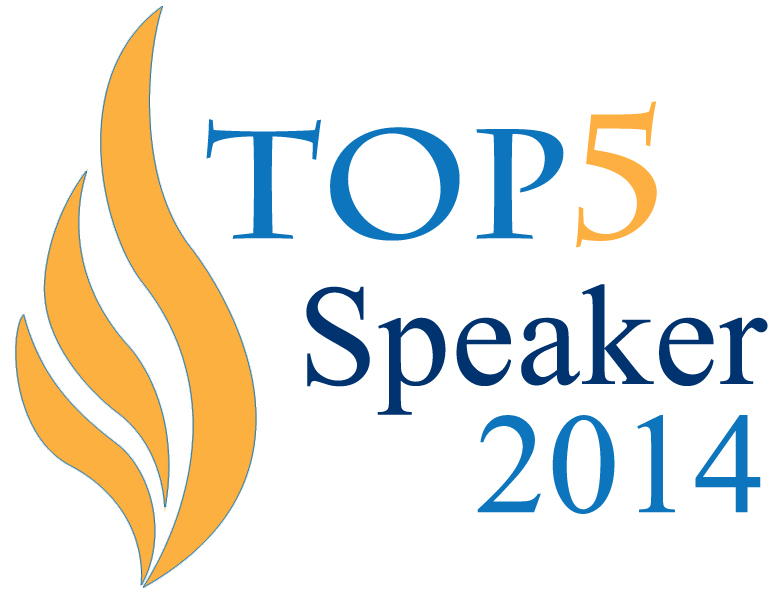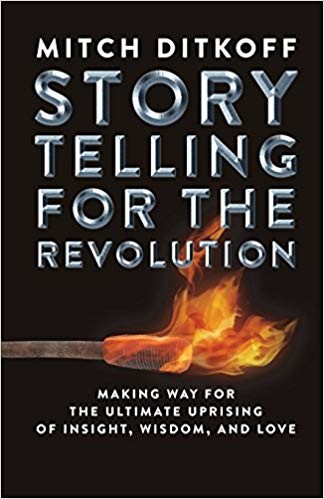Guess Who's a TOP FIVE Speaker in the Field of Innovation & Creativity?

Idea Champions is happy to announce that its Co-Founder and President, Mitch Ditkoff, has just been acknowledged as a TOP FIVE speaker in the field of innovation/creativity by Speaker's Platform, one of America's leading speaker bureaus.
Here is a brief profile of Mitch and links to the topics of his keynotes. Here's his approach to keynotes -- published in the Huffington Post last year.
What our clients say
Idea Champions
Posted by Mitch Ditkoff at 09:39 AM | Comments (0)
January 28, 2014A Conference Call in Real Life
Posted by Mitch Ditkoff at 02:05 AM | Comments (0)
January 27, 2014Creators on Creating
Idea Champions
What We Do
Sampling of our articles
Our innovation keynotes
Posted by Mitch Ditkoff at 07:41 PM | Comments (0)
January 24, 2014The Joe Belinsky Factor

"Time is relative," explained Albert Einstein. "When you touch a hot stove for a second, it feels like eternity. When you sit with a pretty woman for an hour, it feels like a second."
In modern-day business, time is not only relative, it's also hard to find. No one seems to have any these days. Speed has become the name of the game -- everyone searching, in thousands of hyper-caffeinated ways, to get things done faster.
Whereas some early inhabitants of North America -- the Hopi Indians, to be precise -- assessed the value of their actions by the impact they'd have seven generations out, the rest of us are watching the atomic clock.
We live in the land of next quarter, next week, or -- this just in -- next nanosecond.
I'm not proud to admit it, but I, too, was subject to this same chronologically challenged behavior. That is, until I met Joe Belinsky.

Joe, a manager from Goodyear Tire attending one of my creative thinking workshops, was so moved by his experience that he came up to me afterwards, eyes on fire, and declared:
"I'm going to bring your company into Goodyear. We really need to get out of the box."
"Great idea," I replied. "How would you like to proceed?"
"I'll call you when things clarify," Joe said.
And he did -- one year later.
"Joe Belinsky on Line 2," Nancy signals me from across the room.
"Cool," I think to myself.
Joe, as I remembered him to be, was buoyant, buzzed, and mid-westernly beatific. After the predicable niceties, he tells me that "the time still wasn't quite right -- the powers-that-be weren't quite ready to pull the trigger."
"No problem," I reply. "Call us when the dust settles."
One year passes.
"Joe Belinsky on Line 2," Nancy signals me again. "The guy from Goodyear."
Joe, once again, is the perfect gentleman, catching me up on everything he cares about -- his wife, his kids, the Cleveland Cavaliers, and how he is still using the techniques I taught him just two years ago. But... um... you see... there had just been this recent reorg in R&D and... well... the time wasn't quite right.
"Completely understandable," I blurt, doing a quick calculation, in my head, of all the money we were not about to invoice.
Another year passes. Then another. And another. Then two more after that. Seven years altogether -- a biblical cycle of sorts. Not locusts. Not frogs. Not Egyptians chasing Hebrews. Just seven years of Joe Belinsky calling on Line 2 and explaining why it still wasn't the right time for his company to bring us in.
After the fourth year of this now very predictable phenomenon, Joe had become something of a legend in our office.

Having studied Indian cosmology in my early 20's, it was rapidly dawning on me that Joe may have been the harbinger of some kind of esoteric teaching about time.
Time, you see, in India, is not measured in the same way it's measured in the West. Indeed, there is a unit of time in India -- the Yuga -- that, once understood, completely changes one's perspective of how long anything takes. A Yuga is a span of 24,000 years -- or, as the cosmically inclined Indian sages like to say "a single in-breath and out-breath of God."
That's a lot of nanoseconds.
It was now seven years from the first time I met Joe Belinsky -- seven years from the first time he declared his down home interest in "bringing us in" -- seven years from the first time Nancy told me he was on Line 2.
And then the strangest thing happened. The phone rang. It was Joe Belinsky.
"Hey Mitch, guess what?" he blurts.
"Um... let me see... headquarters burned down... the CEO was abducted by aliens... you're having a sex change operation."
"Nope. Not even close. It's time."
"It's what?"
"It's time," Joe assures me once again. "It's time to bring you guys in to Goodyear."
And lo, I say unto you, it was.
In two weeks the contract was signed. A month after that I was leading my first creative thinking session at Goodyear. A few months after that Joe was a certified Idea Champions facilitator and leading his own creative thinking sessions. Plus, I got to go bowling with Joe and his friends, not to mention watching The Mummy on his 57" flat screen TV after a home-cooked meal made by his wonderful wife, Joan.
For the next two years, 40% of my company's revenues came from Goodyear. And I learned more about the fabulous world of tire techology than any seven generations of Hopi Indian elders could ever hope to learn in a Yuga.
COMMENTARY
There is a classic story in the Zen tradition about a monk who lived in a monastery for 20 years doing his best to achieve enlightenment. But no matter what he did -- or didn't do -- his much sought after enlightenment experience never came.
Disillusioned, depressed, and playing out the full meaning of "bummed out", Japanese style, he left the monastery and got a job as a sweeper at a local cemetery.
One week into it, as he went about his mundane maintenance tasks, a brick he swept hit a tree and broke in half. When it did, he also broke in half. Metaphorically, that is.
Something opened up in him. Something beyond time. The enlightenment came. Not in a monastery surrounded by monks, but in a cemetery, surrounded by gravestones.
The result the monk had been seeking for all those years was not a function of time.
And while one could easily conclude that his 20 years of monastic life had created the fertile conditions for his spontaneous, brick-breaking awakening in the graveyard, the fact remained, he was never -- for the entire 20 years of his monkhood -- more than a nanosecond away from what he was seeking.
And while he may have never put his hand on a stove for a second or sat with a pretty girl for an hour, he definitely had his own experience of time's relativity and, even more so, the quickening of what exists beyond time.

Me? I continue to be astounded, daily, by how inaccurate my assessment of time is. I make plans for the day, week, month, and year and rarely are they remotely close to what really happens. Things take longer. Way longer. Murphy's law abounds.
One thing is now clear to me: I don't manage time. Time manages me. And that's not because I'm a bad manager -- but because there are some things that cannot be managed in the way I think they need to be managed.
Time is one of them. Death is the other. The third? Trying to get my teenage daughter to clean up her room.
Excerpted from Storytelling at Work
Posted by Mitch Ditkoff at 10:35 PM | Comments (3)
January 18, 2014Einstein on Mistakes

"Anyone
who
has
never
made
a
mistake
has
never
tried
anything
new."
- Albert Einstein
Idea Champions
The Innovation Accelerator
Brainstorm Facilitation Training
Applied Innovation for High Potentials
Posted by Mitch Ditkoff at 09:17 PM | Comments (1)
January 17, 2014What Business Can Learn from Baseball

A few years ago I ran across an article that got me thinking about how what we measure can change the way we think about what we measure, and how the latest technology that enables us to measure more and more things is not always our friend.
For several decades now, baseball scouts and coaches have been using radar guns to measure how hard pitchers throw. In fact, you can always spot a scout at a baseball game because he's the guy in the stands, behind home plate, with the radar gun pointed at the pitcher, zealously jotting down little nuggets of facts in his notebook like a squirrel gathering acorns.
Not surprisingly, baseball people have come to value pitchers who can throw hard (95 MPH and faster).

This seems to make sense at face value, but if we think about it a bit more we have to ask ourselves if throwing a baseball faster actually makes one a better pitcher. The answer is -- not necessarily.
There are many factors that contribute to making a pitcher effective:
1. Does the pitcher throw the ball exactly where he wants to throw it?
2. Is it easy or difficult for the batter to see the ball coming out of the pitcher's hand?
3. Can the pitcher throw his array of pitches at different speeds, confusing the batter's timing?
4) Can the pitcher deal with adversity, or does he get rattled when things go wrong?
These factors are all more important than how hard a pitcher throws a baseball.
But baseball's obsession with pitch speed, enabled by the ease of measuring speed with a radar gun, has caused some organizations to lose focus on what they're really trying to gauge; that is, the pitcher's effectiveness -- can he get batters out?
A few years ago, the Kansas City Royals conducted an experiment to test the existing assumption that faster is better.
Dayton Moore, the General Manager of the Kansas City Royals, has issued an edict banning radar guns from the lower levels of the organization -- the place where young players first go to develop their skills.
Moore believed that eliminating radar guns from the minor leagues would eliminate a big distraction for young pitchers -- getting caught up in throwing hard in order to be noticed and promoted and forgetting to develop other, key pitching skills.
It may take some time to determine if Moore's hunches turn out to be right, but I, and a host of soft-throwing pitchers in the Baseball Hall of Fame, like Whitey Ford and Hoyt Wilhelm, are willing to bet that they are.
I will end my baseball rant with the following quote from the contemporary economist. Adam Smith:
"Some years ago the sociologist and pollster, Daniel Yankelovich, described a process he called the "McNamara Fallacy", named after the Secretary of Defense, Robert McNamara, who had so carefully quantified the Vietnam War.
'The first step,' he said, 'is to measure what can easily be measured. The second is to disregard what can't be measured, or give it an arbitrary quantitative value. This is artificial and misleading. The third step is to presume that what can't be measured easily isn't very important. This is blindness. The fourth step is to say that what can't be easily measured really doesn't exist.'
The philosopher A. N. Whitehead called this tendency, the Fallacy of Misplaced Concreteness.
Are contemporary business and government leaders all too quickly and lazily falling into the trap of McNamara's Fallacy? Are we measuring only that which is easy to measure (and money, for one thing, is easy to measure) and making decisions based merely on those numbers because other important factors, such as long-term effects on quality of life and the environment, are just too difficult to quantify?
Should we all be rethinking what we measure and why, just like the Kansas City Royals did? And what are our own industry's "radar gun measurements" that give us easy-to-acquire numbers that gather importance simply because they're easy to get?
And if you're still not convinced, consider what Albert Einstein had to say about the topic: "Not everything that counts can be counted and not everything that can be counted counts!"
-- Val Vadeboncoeur
Idea Champions
The author of this article teaches this course
Posted by Val Vadeboncoeur at 02:43 PM | Comments (1)
January 16, 2014The Value of Nothing

When children are born prematurely, they're placed in incubators. When fields stop producing, farmers let them lay fallow. When baseball players are in a prolonged slump, they're given a day off.
It's the same with innovators -- or should be.
They, too, need to incubate. They, too, need to lay fallow. They, too, need time off. You already know this. That's why you often choose to "sleep on it" before making a big decision.
Pausing isn't procrastinating. It's an act of renewal -- a chance to relax and let your subconscious shine -- a phenomenon that's all-too-rare these days -- especially in organizations where everyone is overworked, overwhelmed, and over-caffeinated.
Face it. Sometimes the best thing to do is nothing.
THE DO NOTHING TECHNIQUE
1. The next time you are working hard, but getting no results -- notice it.
2. Take a break.
3. If you feel the urge to produce, let the urge pass.
4. During this down time, simply notice the ideas and insights that come to you.
5. DO NOT attend my webinar on this subject. (I don't have one).
Listen to your subconscious
Excerpted from Awake at the Wheel.
Posted by Mitch Ditkoff at 10:24 PM | Comments (1)
January 13, 2014Want a Brainstorming Breakthrough? Get the Right Question!

There's a simple reason why so many brainstorm sessions are a waste of time. The problem statement being pitched to participants is the wrong one. This is not surprising -- especially when you consider how little time most facilitators put into preparing for a session.
Here's what happens: The person who calls the session is usually scrambling -- overwhelmed, over-caffeinated, and running from one meeting to the next. Out of breath, they pitch the topic to the group, but the topic is either vague or secondary to a more essential challenge that remains unspoken.
G.K. Chesterton, one of the most influential English writers of the 20th century, distilled the phenomenon down to 13 words. "It's not that they can't see the solution," he said. "They can't see the problem."
Then, of course, there's also the phenomenon of perception bias.
Pitch a challenge to an IT person, and it will be seen as a technology problem. Pitch it to a CFO, and it will be seen as a financial problem. Pitch it to a marketing person and it will be seen as a branding problem.
Or as a wise man once said, "When a pickpocket meets a saint all he sees are pockets."
If you plan on running an ideation session any time soon, don't just stumble into the room and pitch a vague topic to the group. Do your homework. Make the effort to identify the REAL issue before asking for ideas. If it's the WRONG QUESTION you present, no amount of idea generation is going to make a difference.
What question would you like to see your team brainstorm in the next week or so?
Brainstorm Facilitation Training
Brainstorming Sessions
Posted by Mitch Ditkoff at 04:06 PM | Comments (3)
Suspend Logic, Linearity, and Analysis (at least for a few minutes)! Perhaps Einstein said it best when he declared "Not everything that can be counted counts and not everything that counts can be counted."
Perhaps Einstein said it best when he declared "Not everything that can be counted counts and not everything that counts can be counted."
He was referring, of course, to the part of the human being that knows intuitively -- the part that is tuned in, connected and already creative. Kids live in this place. The rest of us only visit, preferring the left-brained world of rationality, logic, linearity, practicality and analysis.
On some primal level, we're all from Missouri. We need proof. And while there's nothing wrong with gathering data, the addiction to it subverts our ability to be creative.
We all know this. That's why we go to the movies, the pub, watch TV, read novels, dial 900 numbers, and daydream. We seek an altered state -- one that is free of the normal gravity of daily life...
That's why movie makers ask us to suspend disbelief. That's why brainstorm facilitators ask us to suspend judgment. That's why women (innately intuitive as they are) ask the men in their lives to stop being so damn practical for a change and actually feel something.
It is in this state of suspension that our innate creativity is free to rise to the surface -- over, under and around all of the left-brained guardians at the gate.
And so... if you want to really birth a BIG IDEA, you too will need to enter into this state -- at least in the first phase of your new venture. Suspend judgment. Suspend evaluation. Suspend your addiction to the practical.
What exists on the other side is fuel for the fire of your untapped creativity.
What can you do this week to suspend practicality, logic, and rationality in service to birthing your BIG IDEA?
Excerpted from Awake at the Wheel.
Posted by Mitch Ditkoff at 02:51 PM | Comments (0)
January 09, 2014How Do You Define Yourself?
OK. Time to take a break from your business, your projects, and your fascination for innovation and watch this 13-minute TED video. It's a powerful message from a courageous young woman. A good link to send anyone you know who is struggling with the way they look or the way others treat them.
Posted by Mitch Ditkoff at 09:19 PM | Comments (0)
January 07, 2014Why a Diversity of Participants in a Brainstorming Session is So Important

"Creativity is just connecting things. When you ask creative people how they did something, they feel a little guilty because they didn't really do it, they just saw something. That's because they were able to connect experiences they've had and synthesize new things. Unfortunately, that's too rare a commodity. A lot of people haven't had very diverse experiences. So they don't have enough dots to connect, and they end up with very linear solutions." -- Steve Jobs
One of the challenges of facilitating a successful brainstorm session is ensuring that the right people are in the room, so you have enough "dots to connect." Defining what "right" means, of course, is, itself, a challenge.

Yes, you want a high level of expertise, talent, and decision making authority in the room. But these qualities often result in the "usual suspects" syndrome -- inviting the same people (or the same kinds of people) again and again to your sessions.
If you only invite the usual suspects. it's likely that your brainstorming sessions will get stranded on an island of group think.
People with the same history, careers, education, expertise, interests, and worldviews will typically approach a challenge in the same way.
This is, shall we say, not optimal.
But there's a simple antidote to this phenomenon -- one that is freely supplied by Mother Nature. Diversity.
With a seeming overabundance of species on Earth, it would take a total destruction of the planet for all Life to cease. Short of total destruction, at least some species will continue and, in a few hundred million more years, who knows what new kinds species will emerge?
In the same way, diversity is an excellent survival strategy for a brainstorm session. Not just the diversity of techniques used, but the diversity of participants.
Diversity adds value in two ways: First, it gives the group more dots to connect (as Steve Jobs notes above). And, second, it increases the appearance of creative tension in the room, an important variable in any kind of solution-finding process. Indeed, it's in the super-charged space between two varying points of view where the greatest potential for breakthrough ideas exists.
Thesis + Antithesis = Synthesis.
So, in order to get "more dots" in the room to connect, as well as more creative tension, it's your responsibility to invite a varied mix of participants.
Include the old hand and the beginner, the expert and the novice, the white collar and the blue collar worker, extroverts and introverts, the right brainers and the left. The more varied the group, the better. And, I might add, the more challenging your facilitator role will be.
Animated by a cornucopia of views, experiences, and knowledge, the chances of your brainstorm session succeeding will increase exponentially.
-- Val Vadeboncoeur
Brainstorm Facilitation Training
High Velocity Brainstorming
Why Train People to Be Master Brainstorm Facilitators
Posted by Mitch Ditkoff at 10:59 PM | Comments (0)
January 03, 2014Innovation in Loving Our Fathers

If you're reading this, there's a good chance you are involved in some kind of effort to innovate and get out of the so-called box. But there's also a good chance you have a father -- living or not. In either case, you might find this just published article of mine, in the Huffington Post, timely -- written just one day after my own father passed away in 2009. It will take you less than four minutes to read, but may tap into some timeless feelings.
Posted by Mitch Ditkoff at 05:05 PM | Comments (0)














